Working Week 2
This week, I kept trekking along on my big campaign, and my Canva skills have seriously improved. One of my favorite parts of my workday is our daily intern lunch at the Hawker Center. Owen, Eamon, Autumn, and I all walk over together, and it’s a great time to chat and enjoy some really good food with very kind people—there is never a dull moment with the three of them.
Immersed in Bali
For the long weekend because of Eid al-Fitr, the end of Ramadan, Ariana, Lauren, and I went to Bali. What a blast that was and the most memorable cultural experience of my life! We arrived late afternoon on Friday, and the hour-and-a-half ride to the hotel made for a perfect cultural driving tour. Approximately 87% of the population is Balinese Hindu, which varies from traditional Hindu practices. We arrived the day before Nyepi, which is called Tawur Kesanga. There is a ceremony at the main village crossroad, which is the meeting place of demons. Ogoh-Ogoh are giant monsters built to symbolize these evil spirits, which we saw several of along their journey. While they did slightly scare me, I was able to look objectively and notice the beauty of the hard work and commitment that went into the detailed giant monsters. They have everything from fangs, bulging eyes, and vicious expressions. Following sunset, the parade typically begins, which is accompanied by Balinese gamelan music. We were fortunate enough to see the final touches being assembled as we drove in and were able to see them in action as we walked around the village near our hotel. I found it really surprising but also inspiring that most of the people I saw preparing the Ogoh-Ogoh were around the same age, if not younger than me. I can’t think of anything in American culture where the youth seemingly have such a big role and need to bring something together.

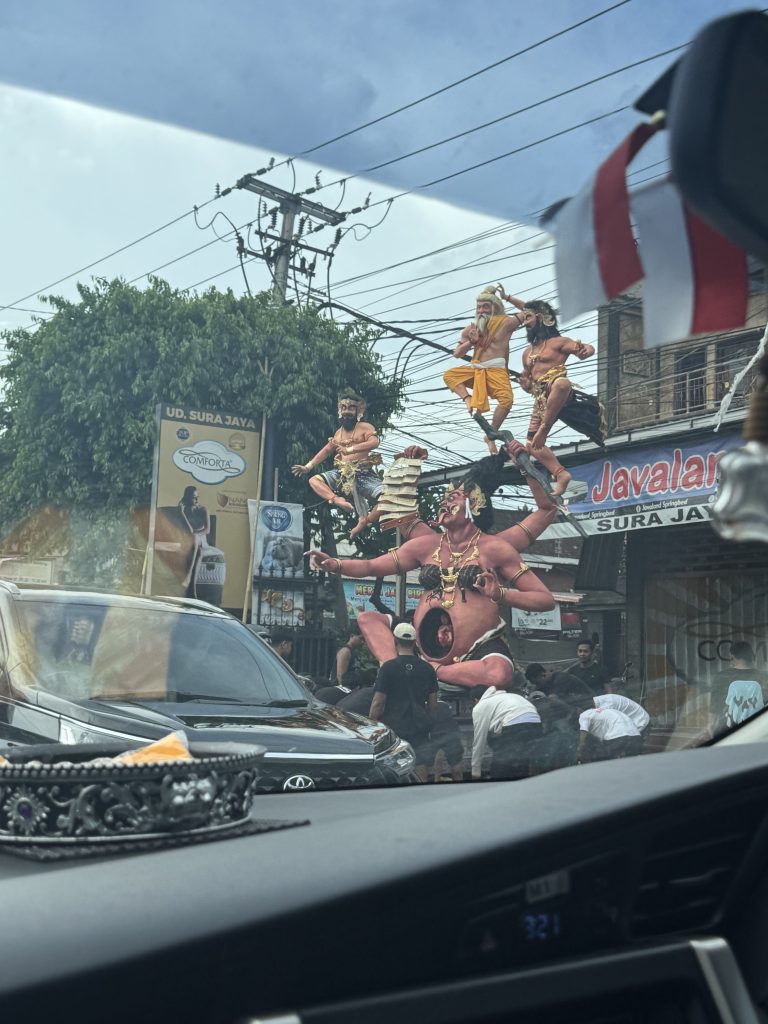
Saturday was the big day, Nyepi Day, or the day of silence, where complete calm takes over the island. After we booked, Ariana realized we would be there for Nyepi Day, meaning we could not leave the hotel for a whole day of a three-day trip. Truthfully, I was a bit upset that we would be missing out on sightseeing. However, after everything I got to experience, I would suggest everyone looking to visit Bali plan their trip around Nyepi. I mean, everything shuts down—you can’t check in/out of your hotel, the airport is completely shut down, shops, and even cellular data was turned off! Could you imagine trying to turn off 5G data and telling people they can’t leave their property for an entire day? I don’t think so. There was so much beauty and power that entered Bali on Saturday because an entire society, for their religion, takes a day to allow Mother Nature a day of reset for working so hard for 364 days. It leaves me speechless, to be honest. I could go on and on about the blissful magic I felt getting to be a part of this special day, but it wouldn’t be enough to paint a vivid enough picture.
I will point out that the hospitality industry did work, which I felt badly about because religiously, they should be doing leisure activities, but the way of the world does not permit it with tourism being such a large part of Bali’s employment. We stayed at Bisma Eight, and they were the most kind and gentle people I’ve ever met—everyone in Bali was, for that matter. But they had amazing activities to fill the day, and I felt honored to learn about their Balinese culture firsthand. I started off the morning with a yoga class, which was so peaceful, getting to listen to the birds and the swaying of the trees. After yoga, I attended a Canang Sari Class, where I got to learn how to make a traditional Balinese offering. It was me, a woman from Egypt, and another woman from Phuket, and the hotel employee Sang Ayu, who was one of the loveliest people I’ve ever met. I arrived at the class first, so I had some one-on-one time and asked what felt like fifty questions in the span of three minutes. Some of the highlights from the class were that they make the offering every single day. Let me say that again—every single day. Traditionally, it’s the women who create the offerings, and the class lasted an hour, and I only made one, but they make several depending on the size of their family and how many home temples they have. Sang Ayu did admit that with work, you have to find the time to make them, or more people are going to the market to gather supplies rather than growing them themselves, but I still found it very impressive. We were fortunate enough to get to use staplers to attach our young coconut leaves together, but back in the day, they would take bamboo sticks and weave in and out to bind the leaves together. Could you imagine?
So, what does a traditional offering consist of? As I mentioned, the young coconut leaves are the first step in making the traditional offering. Young girls from about the age of eight or so learn how to use sharp knives to cut the leaves to first get rid of the impurities and then cut away a stick that is found naturally in the leaf (thankfully, Sang Ayu took care of doing the cutting). From there, you have to fold the young bamboo leaves into quarters because you will eventually make a perfect square. Then you create a bottom to the square with more coconut leaves, AND THEN there was this crazy design happening in the leaves that Sang Ayu cut for us, and we had to fan out the pieces to form a circle (please see the photo) to form a layer for the offering. From there, you add various flowers and shredded pandan leaves, but shredded from a knife! Getting to learn and just be a part of the class was beyond anything I could have imagined. The other women were so lovely and shared about their cultures and what they do in their families. For instance, the Egyptian woman talked about how each member of her family takes a step in making cookies, and they sit around talking as they make these cookies. I wish I had a wider vocabulary to express the joy it filled me to hear about other cultures and how they connect with their families in a way that connects them to their ancestors. Sang Ayu typically works at reception, and before we left, she told us this was her favorite class she’s ever done and asked for a picture of the three of us, but don’t worry, I asked for one with her in it too! I know I’m going to remember that hour for the rest of my life. It was so impactful and meaningful in more ways than one.
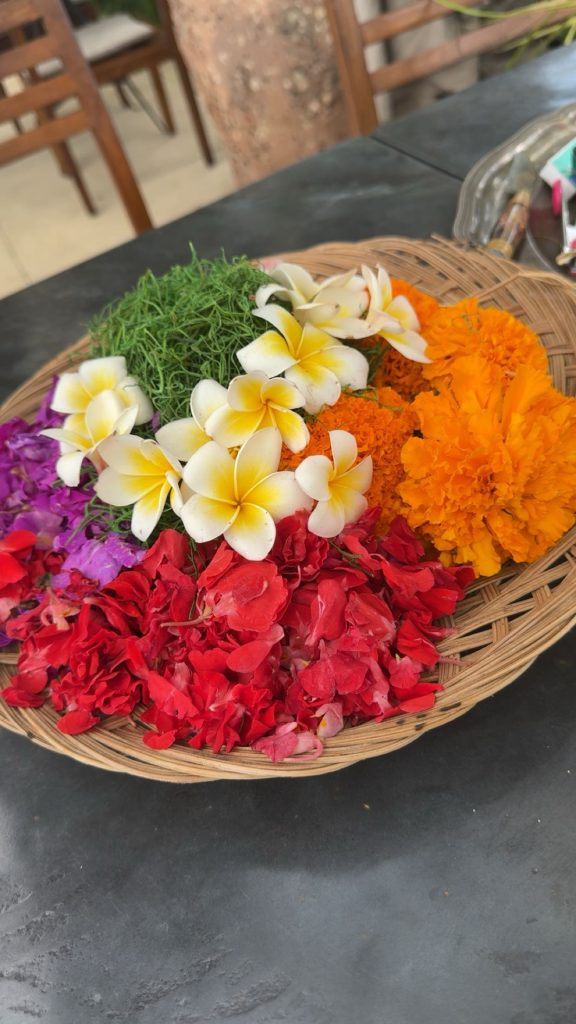
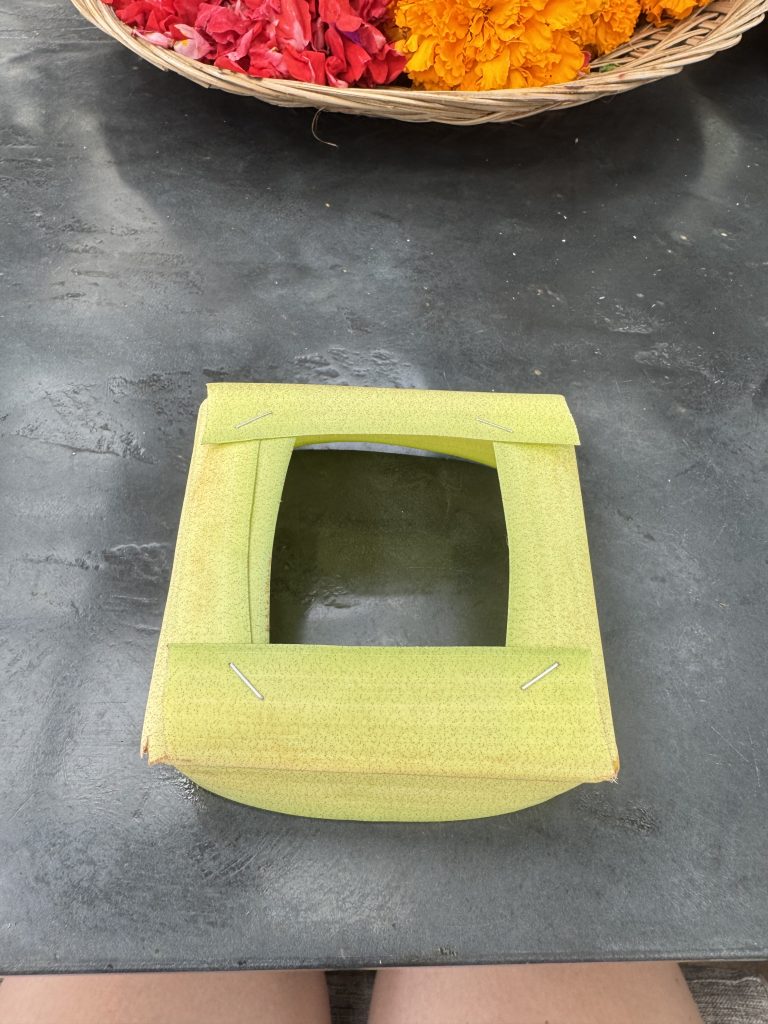
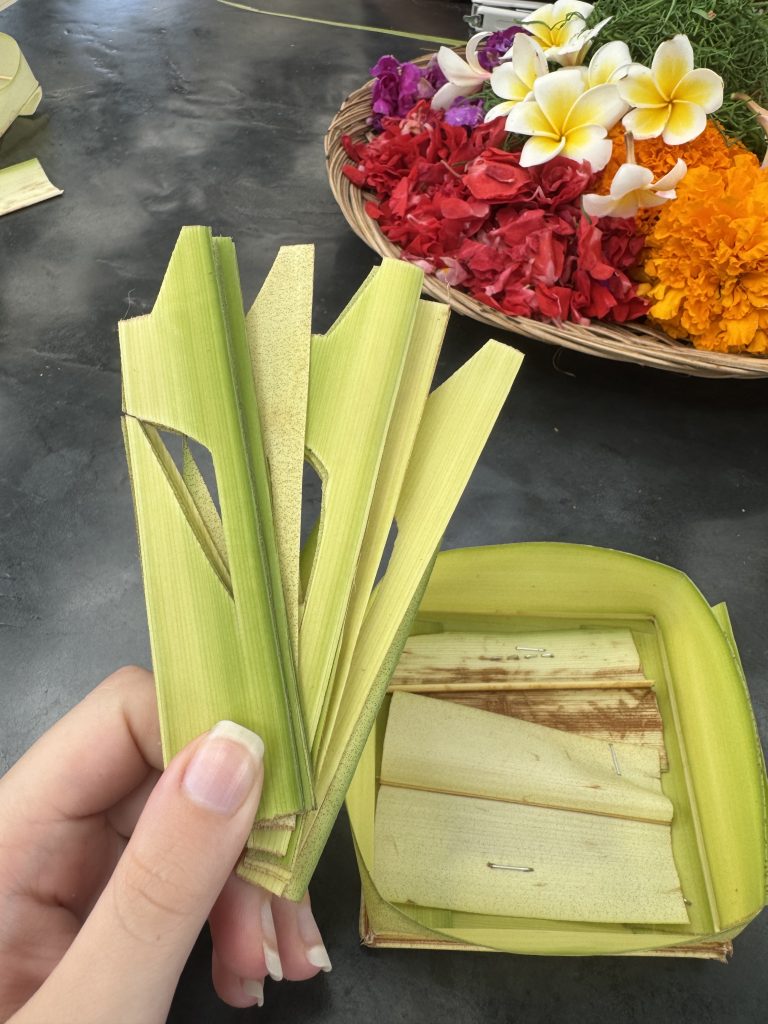

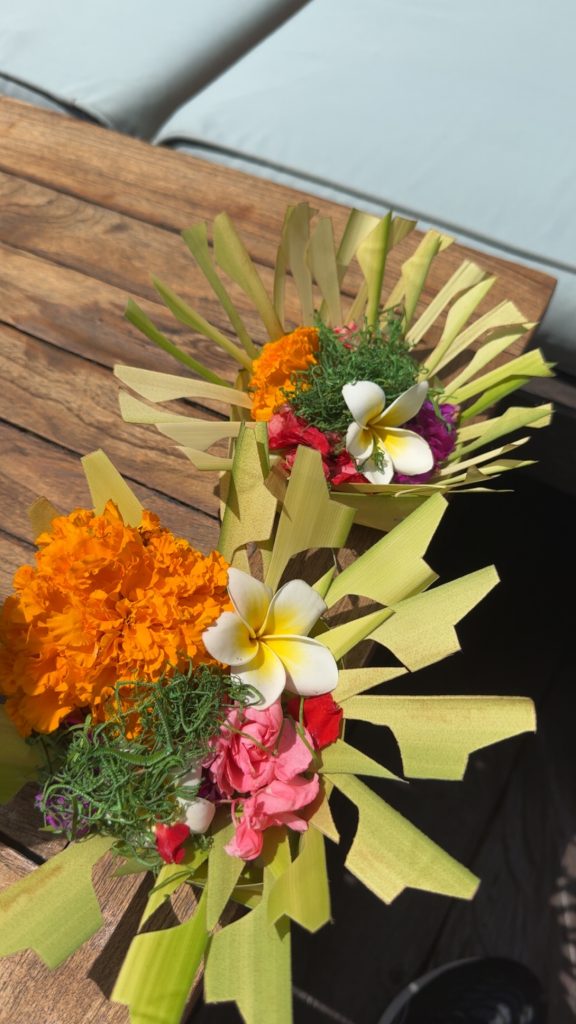
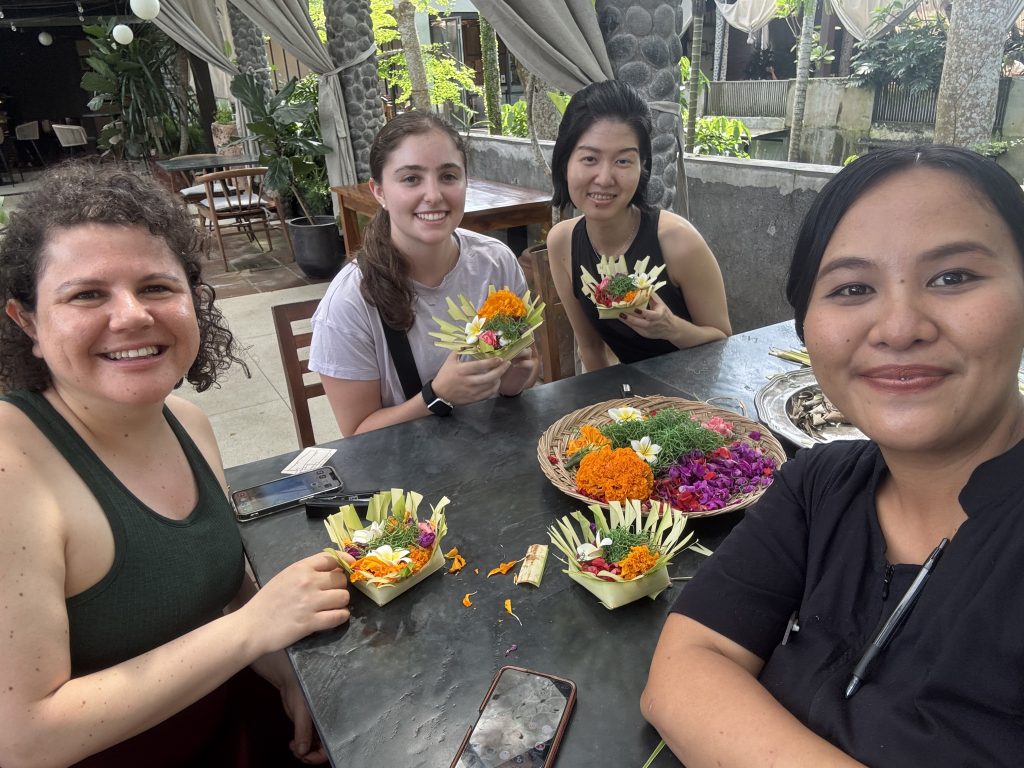
After the traditional offering, I regrouped with Ariana and Lauren to show them my offerings and try to relay as much of the information as I could. From there, we lounged for a bit before we all headed to a Balinese Traditional cooking class, which again was amazing! It was a bit less hands-on, but Nanda, who ended up being our chef that night for dinner, was so patient in demonstrating how to use various spices and how significant cultural dishes come together (sadly, I can’t find my recipe sheet, which had the names of the dishes). After the cooking class, we found some time to let calmness sweep over us, and we spent some time lounging by the pool. After the pool, Ariana and I got massages—it was 60 minutes of heaven. Soon after, we went to dinner where we saw Nanda again, and he told us about how he had traveled to the U.S.—very few Balinese people get to travel because of their currency being so weak compared to other countries. I really pondered on this and how fortunate I am that in my life I have just the possibility to think of somewhere and go there if I really want to, but that’s not the same for everyone.

Sunday, I was up early again for our 8 a.m. tour, which was a private tour with Dika (if you want to go to Bali, he’s an event coordinator and driver, so I can share his WhatsApp). He was chatty in the best way possible, and he knew so much and created an environment that I felt comfortable asking every question that popped into my head as we drove around Ubud. Our first stop led us to a Monkey Forest. There were locals there that helped us interact with the monkeys; sadly, I got a few scratches, but I think it was worth it. Next, we went to Tegenungan Waterfall, and it was stunning, but we couldn’t go swimming because of the undercurrents. Dika warned us that it was 180 stairs down to the waterfall and 180 stairs back up, and while I think Ariana and Lauren will disagree, the climb back up was my favorite. When we made it down, we were cocky because we thought it was a breeze. However, I don’t know if the humidity went up by 100% or what happened, but we were all panting by the time we made it up to the top. Now looking back, I just see how tired the three of us were, and it makes me laugh because we were humbled so suddenly. Once we regained our breath, we made it over to the water temple. It was stunning. To see the various handmade craftsmanship on the temple and the purity of the spring water was breathtaking. You could just feel the positive energy surrounding the temple. Dika was so knowledgeable and was telling us everything from what was old vs. new temple designs, to what it looks like when there is an offering, and the three main Balinese Hindu Gods: Brahma, Shiva, and Vishnu (I believe those are the correct names). We made our way over to the Jungle Swing where Lauren and I put on elaborate flowy dresses, and I surprised myself by willingly going on the swing—I think having the fancy dress played a big factor. Our final stop was to the Rice Terrace, and that was a definite highlight. As previously mentioned, with the low currency, machinery is very expensive, so for rice farmers, they have to do everything manually. From planting each rice seedling to picking it, it’s all done by hand. It was incredible driving by and seeing all the rice farmers (rice is eaten at every meal in Bali by locals). To call it hard work would be an understatement—the devotion they have and the patience I can’t even imagine. It was breathtaking, again. It was just so inspiring to see the hard work and labour that goes into rice, which I simply eat and enjoy without a second thought. It was an amazing tour, and I’m so glad we got to experience so much of Ubud and see the culture firsthand.

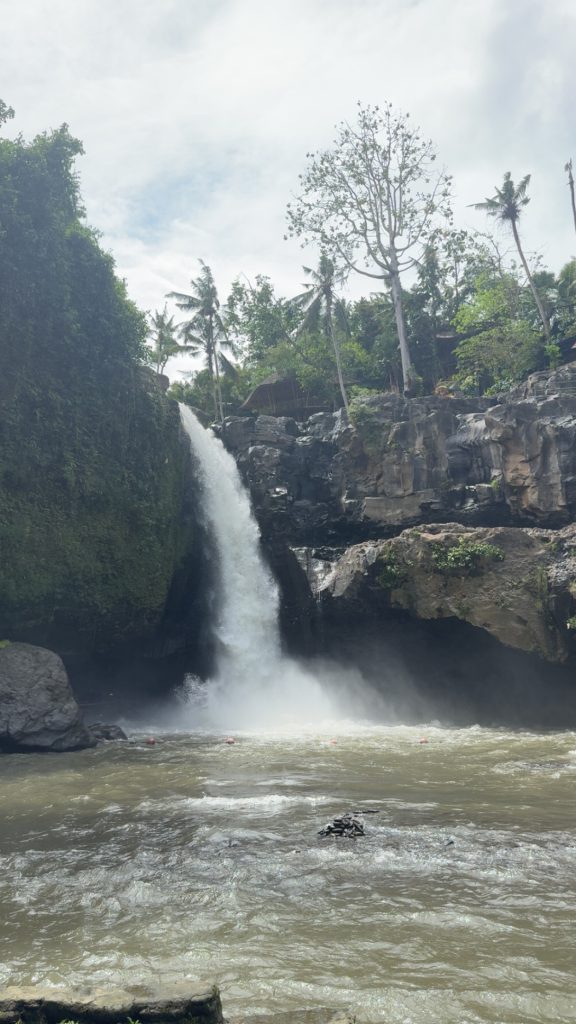
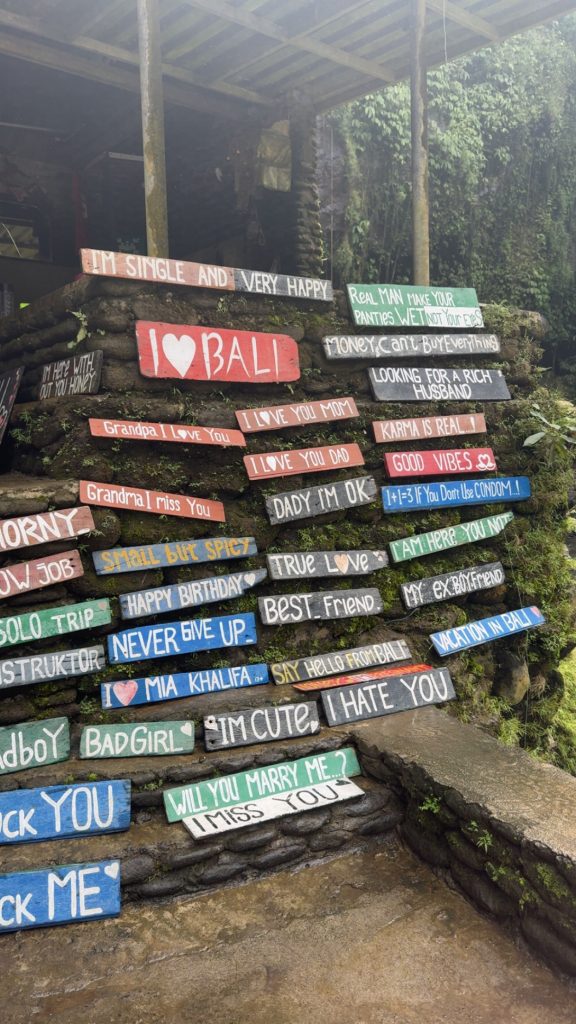
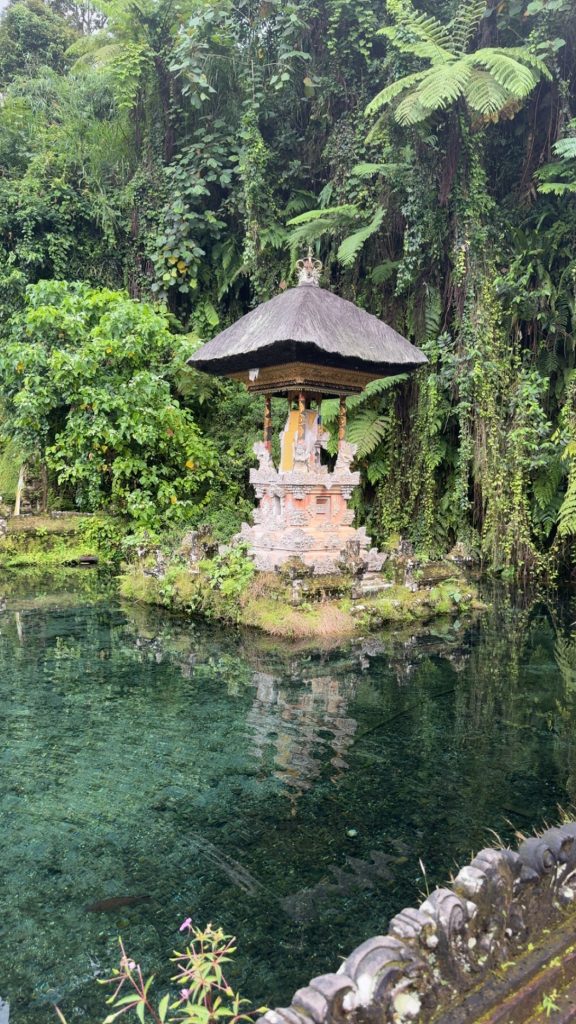
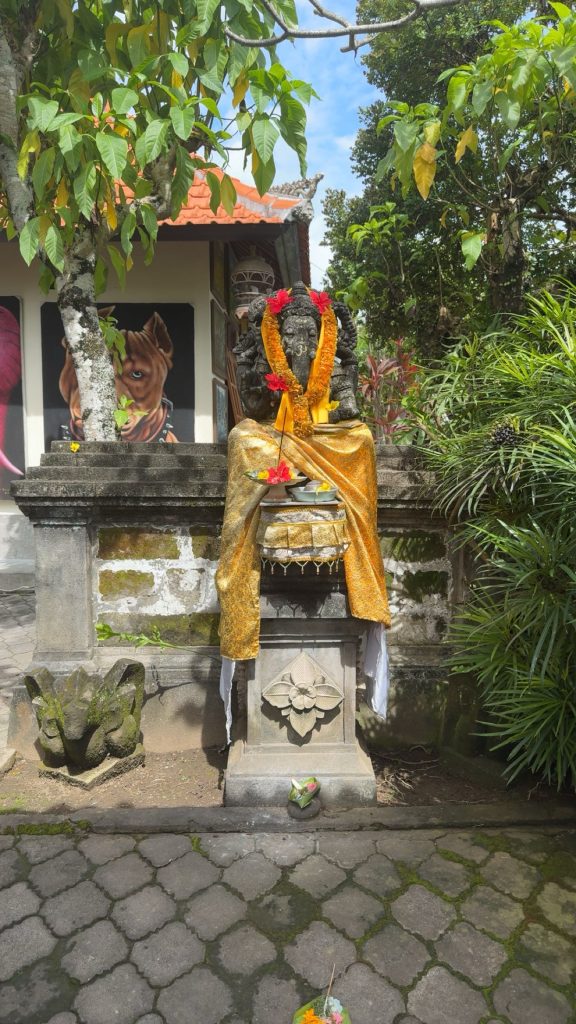
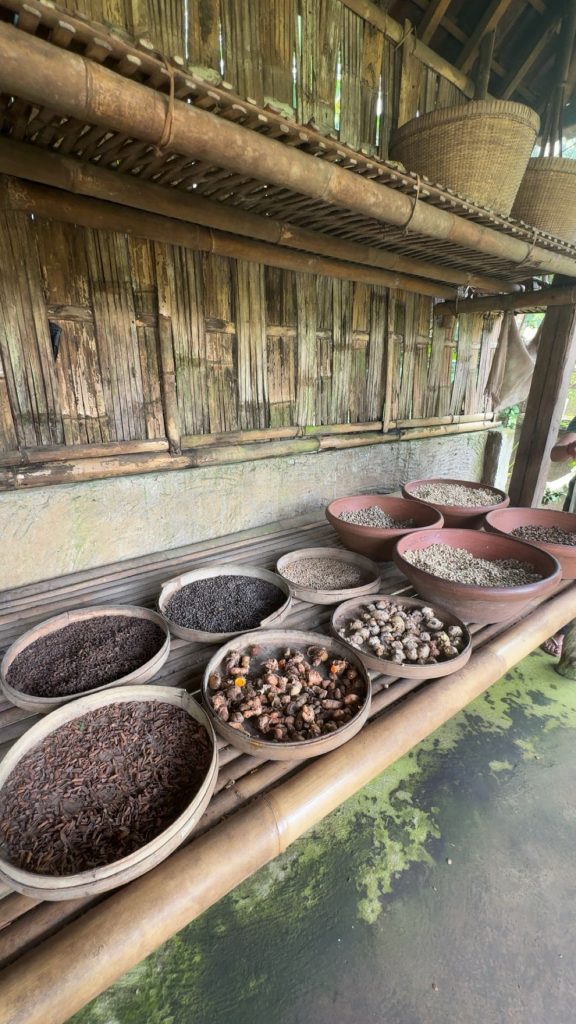

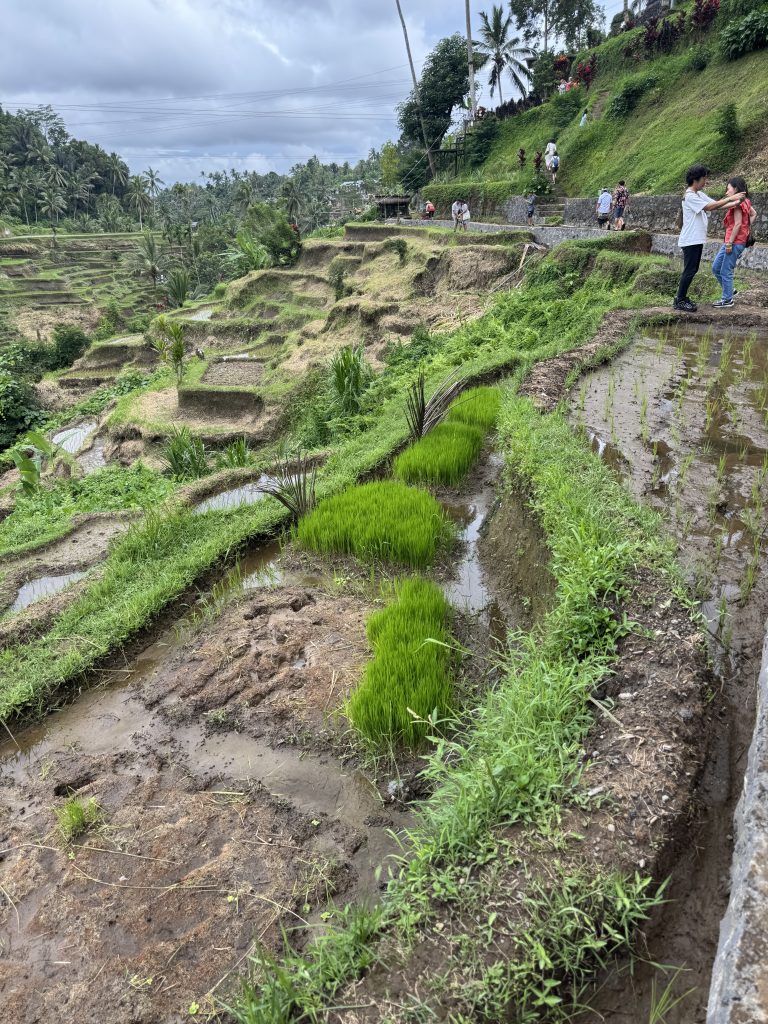
Finally, there were some memorable shopping adventures that I think I should share. The first was to “Silver Village.” We went to this one place, and we got to see these women working away at making jewellery, and their collection of jewellery was huge! I ended up finding my sister a pair of earrings, and I even negotiated the price down. It was my first time negotiating, and at first, I felt uncomfortable, but I started to get relaxed the more the day went on. Our second notable mention, which is my favourite purchase story, was at Iwayan Madiana Painter. I felt very adult purchasing a piece of artwork. We met a very kind man who showed us around his family’s compound, which doubled as the art studio and gallery. All the paintings had been done by various family members. Walking around the compound, I was looking for something to speak to me, and then I found “the one.” The different elements represent prosperity and power, so I think that means only good things lie ahead. The painter, Dewa Restu, is no longer doing any more paintings because he’s sick, so I feel honoured to have the painting and to remember my time in Bali. Our third and final shopping adventure took us to a wood-carving town. Ariana and I fell in love with all the kitchenware from the hotel, and we were determined to bring some back. Ariana and I bought bowls! I also do not have photos of those… and they are securely wrapped up, but they are stunning wooden bowls. Our fourth stop was to a special coffee plantation, Pemulan Bali Coffee Plantation, which uses civets (think of a cat-raccoon hybrid), which eat the coffee beans, then poop them out and ferment them. It’s apparently very expensive when you get it outside of Bali. In Melbourne, Australia, according to Dika, one cup could go for $100 AUD. None of us were brave enough to try it, but it was amazing to see another way of doing something—talk about product differentiation!
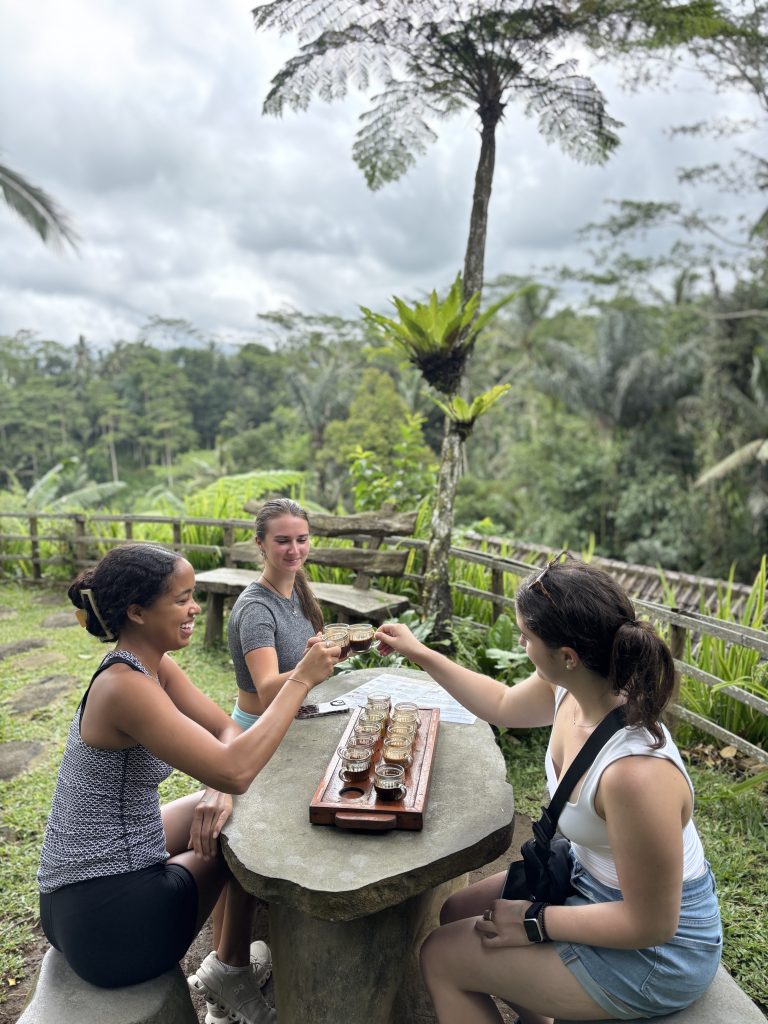
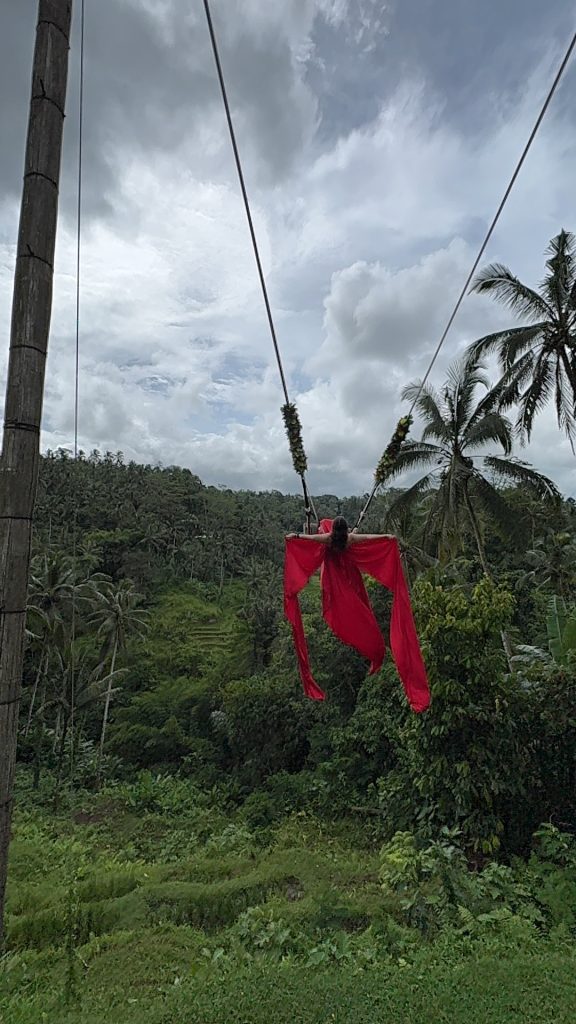

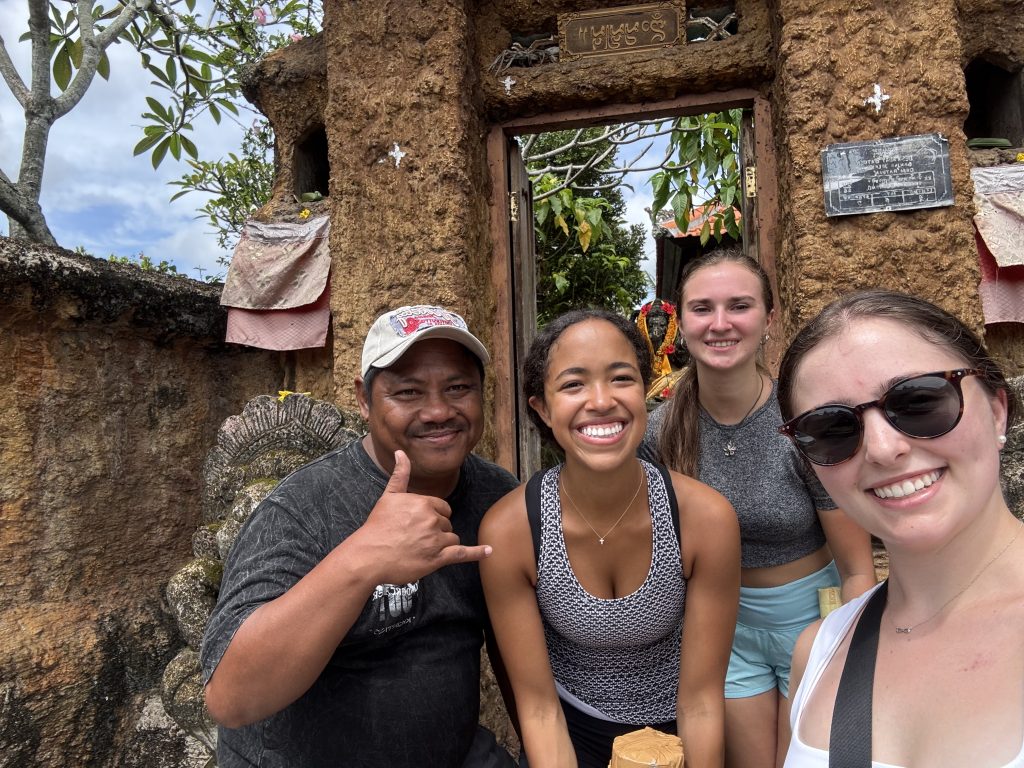
To recap: visit Bali if you can! The further away from the airport, the better, so you can really experience the culture and the strong energy of the island. The people are wonderful, and it’s a completely different way of life that really centred me and led to many moments of reflection. It is by far the best cultural experience I have ever had, and I feel so honored that I was able to witness such a remarkable culture. Until next week!
Cheers!
-Alexa
Another WOW blog. Amazing!
WOWZA! Wish I was there to experience this with you!! xx
Amazing! What a great adventure… you’ll remember this for the rest of your life!